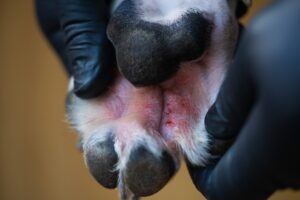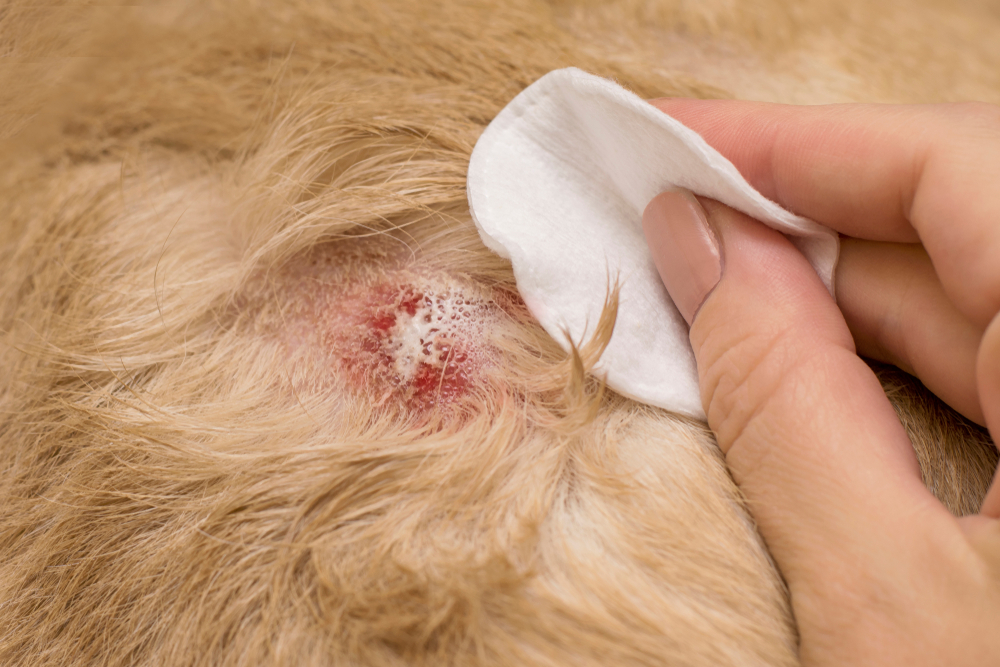Atopic dermatitis (AD) is a common and often frustrating skin condition in dogs that may finally be yielding its secrets thanks to a powerful new diagnostic tool that goes far beyond traditional testing- Next-generation sequencing (NGS). NGS can accurately profile the complex microbial ecosystems associated with AD- offering veterinarians a more precise way to diagnose and treat this widespread disease.
From Paws to Ears: Where AD Strikes
AD affects thousands of dogs across the U.S. each year. It’s a chronic inflammatory skin disease, driven by genetics, immune dysfunction, environmental allergens. This pesky and persistent skin disease tends to flare up in high-contact, moisture-prone areas- paws, ears, armpits, groin, and the abdomen- where licking, scratching, and allergen exposure create perfect conditions for inflammation and secondary infections.
The Microbiota Connection
In healthy dogs, skin harbors a wide range of beneficial bacteria and fungi that help regulate immune function. But in AD, this balance is lost. Opportunistic microbes- like Staphylococcus pseudintermedius and Malassezia– can take over, leading to worsening symptoms and chronic infections.
Traditional diagnostics, such as culture and PCR, are limited in detecting the full picture. Cultures often return “no growth,” especially when slow-growing or anaerobic microbes are involved. PCR tests only find what they’re designed to detect- often missing unfamiliar or unculturable species entirely.
Culture and PCR Can’t Detect AD Effectively
Veterinary practitioners have long relied on cytology, culture, and PCR for diagnosing infectious skin diseases. While useful in identifying common pathogens in acute infections, these techniques fall short in chronic or persisting conditions, like AD. The key limitations to these testing techniques include:
- Bias toward culturable, fast-growing organisms, such as aerobic bacteria
- “No growth” failure to detect slow-growing, anaerobic, or rare microbes
- Limited breadth of detection in PCR, which targets only pre-defined organisms
- No reporting of the entire microbial landscape, or diversity
- Inability to detect AMR genes directly from polymicrobial or non-viable samples
This diagnostic gap often leads to incomplete pathogen profiles, misdirected treatments, and the unnecessary use (and possible overuse) of broad-spectrum antibiotics.
Next-Generation Sequencing (NGS): A Diagnostic Breakthrough for AD in Dogs
That’s where next-generation sequencing comes in. This cutting-edge technology sequences conserved microbial genes (like 16S rRNA for bacteria and ITS for fungi) directly from skin swabs to identify thousands of bacterial and fungal microbes down to the species level, simultaneously!
NGS can:
- Detect all microorganisms, including rare and unculturable species
- Quantify relative and absolute abundances of microbes
- Reveal polymicrobial infections that often go undiagnosed
- Identify antimicrobial resistance (AMR) genes, guiding more targeted treatments

AD Is Not Just Aerobic Organisms
MiDOG Animal Diagnostics offers NGS-based testing that covers both bacteria and fungi. With this type of test, we now know that AD is not only caused by aerobic bacteria but could be due to a cluster of a variety of pathogens!
In a recent case study conducted by MiDOG Animal Diagnostics and Dr. Wayne Rosenkrantz, we reported the first known instance of deep pyoderma in a dog. Initially, using cytology, histopathology, and culture, it was presumed that typical aerobic bacteria cause the skin disorder.1 However, after using MiDOG’s NGS testing, it was revealed that it was caused by Burkholderia gladioli, which developed after immunosuppressive therapy with ciclosporin and prednisone! It was only by NGS that we learned cutaneous infections in dogs may involve complex polymicrobial communities—not just aerobic bacteria typically targeted by standard diagnostics. Fortunately, the dog made a full recovery following immunosuppressive dose reduction and a 6-week course of marbofloxacin, underscoring the importance of advanced molecular tools in uncovering the full microbial landscape of chronic skin infections.
Landmark Study: Large-Scale NGS Analysis of Canine Ear and Skin Microbiota
In a landmark study conducted by our team at MiDOG Animal Diagnostics, we analyzed the skin microbiota from over 300 dogs- both healthy dogs and those with skin disorders- to determine the microbial composition using NGS.2
The findings were eye-opening!
- Using NGS, were identified key bacterial and fungal players in AD- Staphylococcus (S.) pseudintermedius, schleiferi,and Malassezia pachydermatis,
- Importantly, anaerobic bacteria like Finegoldia magna, Peptostreptococcus canis, and Porphyromonas cangingivalis were also detected at noteworthy abundances- species that rarely appear in standard cultures.
- This is the first time we’ve been able to quantify how much of a certain microbe tips the balance toward disease!
The study also showed that clinically affected dogs had lower microbial diversity, a key feature of dysbiosis. By measuring both relative and absolute abundance, researchers were able to better define what constitutes pathogenic overgrowth.
The results underscore the superiority of NGS in diagnosing polymicrobial infections and guiding effective treatment.
A New Era in Veterinary Dermatology
Atopic dermatitis in dogs is a complex inflammatory disease intricately linked to microbial dysbiosis. Traditional diagnostics- while useful- often fail to capture the polymicrobial, dynamic nature of the microbial communities involved.
But- Atopic dermatitis is no longer just a guessing game! Next-generation sequencing offers a transformative alternative. It enables accurate detection of both common and rare pathogens, quantifies microbial load, and identifies resistance genes- allowing for precise, personalized treatment strategies.
Our study and the overall work done at MiDOG Animal Diagnostics using NGS underscores the clinical value of comprehensive microbiome profiling and highlights the limitations of conventional diagnostics. As NGS continues to become more accessible, it’s poised to become standard practice in the diagnosis and management of complex skin diseases like AD.
References:
- Rosenkrantz W, Ritter JM, Keating MK, Bhatnagar J, Krumbeck JA. Burkholderia gladioli deep pyoderma in a dog secondary to immunosuppressive ciclosporin and prednisone therapy. Vet Dermatol. 2024;35(5):563-567.
- Tang S, Prem A, Tjokrosurjo J, et al. The canine skin and ear microbiome: A comprehensive survey of pathogens implicated in canine skin and ear infections using a novel next-generation-sequencing-based assay. Vet Microbiol. 2020;247:108764.
Categories: Bacterial Infections, Dogs, Next-Gen DNA Sequencing Technology, Pet Health, Safety and Wellness, Skin Health


